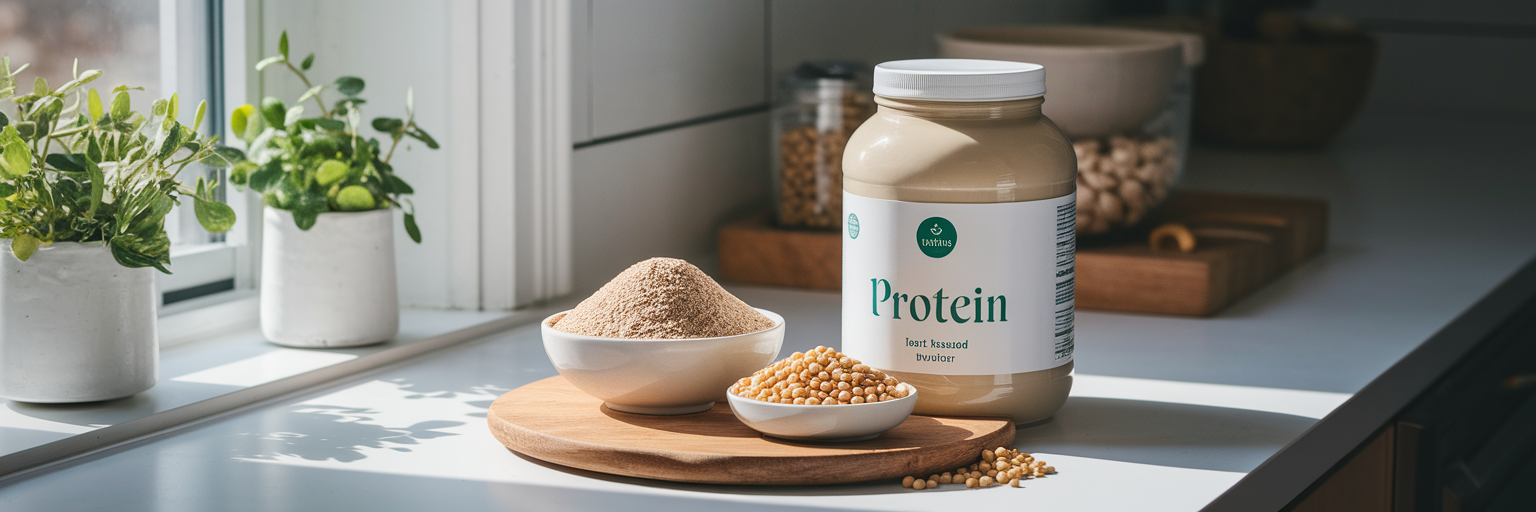We’ve all been there. You blend a beautiful, nutrient-packed protein shake, feeling great about your healthy choice, only to be met with uncomfortable bloating an hour later. It’s a common frustration, and it’s not your fault. The search for a vegan protein for sensitive stomach can feel like a maze, but understanding what causes the discomfort is the first step toward finding a powder that works with your body, not against it.
Why Some Protein Powders Cause Discomfort
That post-shake discomfort often comes down to a few common culprits hiding in plain sight on the ingredient list. While your body is trying to process the protein, it might also be struggling with additives designed to improve texture or sweetness. This is a frequent reason people experience plant protein without bloating issues. Your digestive system is unique, and what works for one person might not work for another.
Often, the problem isn't the protein itself but the company it keeps. Heavily processed ingredients can be tough for the gut to recognize and break down. Let's look at the usual suspects:
- Fillers and Gums: Ingredients like xanthan gum or guar gum are used to create a thicker, smoother texture. While generally safe, they can ferment in the gut and cause gas and bloating for those with sensitive systems.
- Artificial Sweeteners: Sucralose, aspartame, and sugar alcohols like erythritol can be major triggers for digestive distress. They are often difficult for the body to absorb, leading to discomfort.
- Complex Protein Blends: Sometimes, a powder that blends five or six different plant proteins can be overwhelming for a sensitive gut to process all at once, even if each ingredient is healthy on its own.
Thinking about how to choose vegan protein starts with recognizing that simpler is often better. A clean, short ingredient list means your digestive system has less work to do, allowing you to get the benefits of your protein without the unwanted side effects.
Decoding the Ingredient Label for Gut Health

Once you know what to avoid, you can start looking for what to embrace. Reading an ingredient label shouldn't require a science degree. It’s about learning to spot the good stuff and sidestep the potential irritants. This is where you take control and find a truly easy to digest protein powder.
Prioritize Ingredient Transparency
The best philosophy is "less is more." A high-quality protein powder shouldn't have a laundry list of ingredients. Look for brands that are proud of their simplicity. If you can't pronounce half the ingredients, it might be a red flag. The best ingredients in protein powder are often the simplest ones. To see what this looks like in practice, you can explore our collection of clean-label products.
Compare Plant Protein Sources
Not all plant proteins are created equal when it comes to digestion. Some are naturally gentler on the stomach. Understanding the differences can help you make an informed choice.
| Protein Source | Key Digestibility Factor | Best For |
|---|---|---|
| Pea Protein Isolate | Low in fiber and lectins, very smooth. | Those seeking a high-protein, low-FODMAP option. |
| Brown Rice Protein | Naturally hypoallergenic and gluten-free. | A simple, single-ingredient choice for sensitive systems. |
| Hemp Protein | Contains fiber and is less processed. | Individuals who tolerate fiber well and want added nutrients. |
This table offers a general guide to the digestibility of common plant proteins. Individual tolerance can vary, so it's always best to see what works for your body.
Look for Sprouted or Fermented Ingredients
Sprouting or fermenting a protein source, like brown rice or quinoa, helps break down anti-nutrients such as phytic acid. Think of it as pre-digesting the ingredient, making it much easier for your gut to absorb the nutrients without irritation.
Avoid Hidden Sugars and Artificial Sweeteners
Scan the label for natural, gut-friendly sweeteners like monk fruit or stevia. Be wary of artificial options that can disrupt your gut microbiome. Your protein shake should support your health, not create new problems.
The Added Benefits of Enzymes and Allergen-Free Formulas
Beyond the core ingredients, certain additions can make a world of difference for a sensitive stomach. Think of these as bonus features that signal a brand truly understands digestive wellness. One of the most effective additions is a blend of digestive enzymes.
Consider digestive enzymes as little helpers that give your system a hand. Specifically, proteases are enzymes that specialize in breaking down protein molecules, making them easier for your body to absorb. This can significantly reduce the chances of bloating. As noted in a review by Wired, many premium protein powders now incorporate digestive enzymes to improve absorption and comfort.
Choosing an allergen-free formula is another smart move. Even if you don't have a diagnosed allergy to soy or gluten, these ingredients can contribute to a low-grade inflammatory load on the gut. Opting for a powder that is certified gluten-free and soy-free reduces potential irritants, giving your digestive system a break. Likewise, a USDA Organic seal provides assurance that the ingredients were grown without synthetic pesticides, which is another win for gut health.
However, it's important to maintain a balanced perspective. Some "healthy" additives, like inulin or chicory root fiber, can be problematic for individuals sensitive to FODMAPs. While beneficial for some, these prebiotic fibers can cause significant gas and bloating in others. This is a perfect example of why reading the entire label, not just the marketing claims, is so important.
Finding a Smooth Texture Without Unwanted Additives

Let's talk about a common complaint: texture. Nobody enjoys a chalky, gritty protein shake. But that ultra-silky, milkshake-like consistency often comes at a cost. It's usually achieved with the same gums and thickeners that can cause digestive upset.
There’s a direct link between ingredients and mouthfeel. A powder with a slightly more natural, less uniform texture is often a sign of a cleaner formula. On the other hand, an unnaturally smooth blend might be full of the additives you're trying to avoid. Look for terms like "micronized" or "isolate" on the label, as these powders have been milled into finer particles that mix more easily with liquid, improving smoothness without extra ingredients.
The key is to frame this as a positive trade-off. Would you rather have a perfectly smooth shake that leaves you feeling bloated, or a slightly less perfect texture that your stomach loves? We believe a happy gut is worth it every time. Plus, you don't have to settle for a bad experience. You can easily create a perfectly smooth and delicious drink by blending your powder with ingredients like a banana or avocado. For inspiration, check out some of our favorite easy recipes.
How to Test and Introduce a New Protein Powder
Once you've chosen a promising candidate, the final step is to introduce it carefully. Instead of jumping in with a full serving, a methodical approach will help you confirm that you've found the right vegan protein for sensitive stomach care. This process empowers you to become your own health detective and listen to your body's feedback.
- Start with a Sample or Travel Size: Before committing to a large tub, see if the company offers single-serving packets. This is a low-risk way to test the waters.
- Follow the "Start Low and Go Slow" Method: For your first try, use only a half-serving. If that goes well, you can gradually work your way up to a full scoop over a few days. This gives your system time to adjust.
- Keep a Simple Food Journal: Note how you feel an hour or two after your shake. Are you energized and satisfied, or are you experiencing any bloating or discomfort? This simple log can provide clear answers.
- Mix It Smart for the First Few Tries: Blend your new powder with just water or a simple, unsweetened plant milk you know you tolerate well. This helps you isolate the powder as the only new variable, so you can accurately gauge your body's reaction.
This careful testing method removes the guesswork and ensures you can confidently add a new protein to your routine. If you have questions during this process, our FAQs page is a great resource for answers.
Making Your Gut-Friendly Protein a Daily Habit
Finding the right protein powder is an empowering first step. Now, it's time to make it a seamless part of your daily wellness routine. The best protein is one you actually use consistently.
Think beyond the shaker bottle. Try mixing a scoop into your morning oatmeal, blending it into a smoothie with fruit and spinach, or even adding it to pancake batter for a protein boost. The goal is to make it a habit that feels effortless and enjoyable.
Most importantly, continue to listen to your body. Your needs can change over time, so stay mindful of how you feel. Finding a vegan protein for sensitive stomach isn't just about avoiding discomfort; it's about finding a product that helps you feel your absolute best.
If this guide helped you, consider sharing it with a friend who might be on the same journey. And if you're ready to see what a clean, simple, and delicious protein looks like, you might want to explore our gut-friendly chocolate protein.



